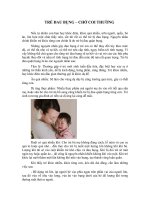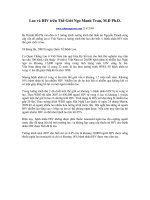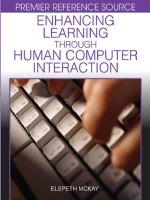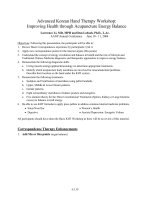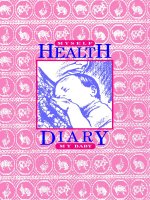Tài liệu Improving Health through Acupuncture Energy Balance docx
Bạn đang xem bản rút gọn của tài liệu. Xem và tải ngay bản đầy đủ của tài liệu tại đây (1.67 MB, 13 trang )
4.3.19
Advanced Korean Hand Therapy Workshop:
Improving Health through Acupuncture Energy Balance
Lawrence Li, MD, MPH and Dan Lobash, Ph.D., L.Ac.
AANP Annual Conference June 10 - 11, 2004
Objectives: Following this presentation, the participant will be able to:
1. Review Basic Correspondence experience by participants; Q & A
2. Apply new correspondence points for the internal organs (Mu points)
3. Understand the concept of energy circulation and balance in health and the role of lifestyle and
Traditional Chinese Medicine diagnostic and therapeutic approaches to improve energy balance.
4. Demonstrate the following diagnostic skills:
a. O-ring muscle testing (applied kinesiology) to determine appropriate treatments.
b. Identify which acupuncture body meridians are involved for musculoskeletal problems.
Describe their location on the hand under the KHT system.
5. Demonstrate the following treatments:
a. Sedation and Tonification of meridians using pellet bandaids.
b. Upper, Middle & Lower Heater patterns
c. Gender patterns
d. Eight extraordinary meridians to balance posture and energetics
e. Five element theory for the Three Constitutional Treatments (Spleen, Kidney or Large Intestine
excess) to balance overall energy.
6. Be able to use KHT formulas to apply press pellets to address common internal medicine problems.
• Sinus/Nose/Ear
• Digestive
• Women’s Health
• Anxiety/Depression: Energetic Valium
All participants should have taken the Basic KHT Workshop as there will be no review of this material.
Correspondence Therapy Enhancements
1. Add Mu or Shu points
(organ balance)
Figure 1
Table 1: Mu points for Yang, Yin,
Kidney excess syndromes
Organ Point
Liver
Spleen
Large Intestine
N19
F19
E22
Bladder
Stomach
A3
A12
2. Add an energetic Heater pattern
To improve energy balance in the
chest, abdomen or pelvis
Fig. 2: Upper, Middle & Lower Heater patterns
Table 2: Three Heaters (Triple Warmer)
Heater KHT points Organs Symptoms
Upper A12, 16, 18, 20 Circulation, Respiration:
Heart, Lung
Chest pain/tightness, Cough,
Dyspnea, Dysphagia
Middle A8, 12, 16 Digestive: Gall Bladder,
Liver, Spleen, Stomach
Nausea, loss of appetite,
indigestion, motion sickness
Lower A1, 3, 8, 12 Reproduction, Elimination Low Energy, constant illness, LBP,
lower GI/GU problems, decreased
libido, urinary difficulties
Traditional Chinese Medicine
TCM considers the patient as a microcosm of the universe, subject to the influences of the environment
and internal harmony. Patients are subject to the interplay of external factors such as wind, heat, dryness,
dampness and cold which act on the elemental qualities of the human body such as wood, fire, earth,
metal and water. Internal factors such as anxiety, sadness, anger, and elation also influence health as
well as the interplay between the classic polar stations of yin and yang.
TCM has a different anatomical and physiological construct which is internally logical and consistent but
different from the Western model. To explain TCM in Western terms is difficult, but to explain TCM
from an Eastern philosophical standpoint is easy. Ultimately, a Western practitioner must accept
acupuncture as a scientifically validated treatment without fully understanding its mechanism of action.
Many drugs in the Western pharmacopeia work clinically but are without adequate physiological
Lawrence B. Li, MD, MPH & Dan Lobash, Ph.D. AANP Annual Conference June 10 –11, 2004 3
Advanced KHT Workshop: Improving Health through Acupuncture Energy Balance
4.3.19
explanations as to their effectiveness. Aspirin was used for more than 100 years before its mechanism of
action was recently elucidated, and this scientific achievement was awarded the Nobel prize.
Energy Circulation
Life energy, or Qi (“chee”) must circulate throughout the body and in the anatomical territory of each of
the internal organs. Qi is said to normally flow along meridians, which are theoretical channels to carry
and distribute Qi. The meridians divide the body into six sagital territories of influence. Blockages in the
flow of Qi are said to cause disease much like blockages of blood flow can cause damage downstream.
KHT Treatment of Energy Imbalance: Overview
1. Five Element Theory —> Three Constitutions: Excess Kidney, Large Intestine or Spleen
• Determine by Muscle Testing or Pulse Taking (hard; 6 months skill)
• Balance with pellet bandaids or rings
2. Micromeridian: Balance through Sedation or Tonification of Energy Flow
3. Eight Extraordinary Meridians: composite superhighway: Balance posture, energetics
Yin - Yang Cycle
Figure 3 Figure 4
Everything flows in cycles. Every organ interacts with other organs. Problems seldom occur in isolation.
Lawrence B. Li, MD, MPH & Dan Lobash, Ph.D. AANP Annual Conference June 10 –11, 2004 4
Advanced KHT Workshop: Improving Health through Acupuncture Energy Balance
4.3.19
Five Element Cycle
Figure 5
Y
ANG
(outer circle)
Gall Bladder
Small Intestine /
Triple Heater
Stomach
Large Intestine
Bladder
Y
IN
(inner circle)
Liver
Heart / Pericardium
Spleen
Lung
Kidney
Table 3: Five Elements characteristics
Table 3
Meridian Excess - Deficiency
Dynamic Energy balance
•
Illness, injury
•
Diet, Activity, Herbs, Acupuncture
•
One change creates many changes; meridian relationships
Figure 6:
S
EE
– S
AW
Increase/Decrease Yin <—>
Decrease/Increase Yang
Chinese Body Acupuncture Map
Table 4
Internal organ names NOT necessarily correlated with organ disease.
12 Meridians (6 pairs) each side of the body
Italicized = Key Diagnostic meridians in KHT
Yin meridians flow out to fingers, in from toes.
Yang meridians flow in from fingers, out to toes.
Organ
Liver Heart Spleen Lungs Kidney
Season Spring Summer Harvest Fall Winter
Element Wind Heat Damp Dryness Cold
Paired
Yang organ
Gallbladder Small
Intestine
Stomach Large
Intestine
Bladder
Emotion Anxiety Joy Thought Sadness Fear
Y
ANG ORGAN
Y
IN
O
RGAN
Large Intestine
Lung
Stomach
Spleen
Bladder
Kidney
Lawrence B. Li, MD, MPH & Dan Lobash, Ph.D. AANP Annual Conference June 10 –11, 2004 5
Advanced KHT Workshop: Improving Health through Acupuncture Energy Balance
4.3.19
Fig. 8: Chinese Body Acupuncture Map, Front & Back views


